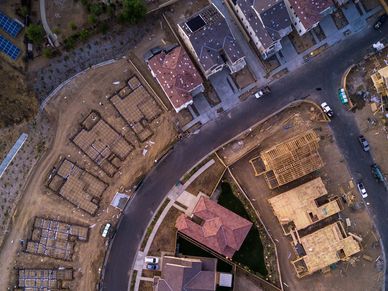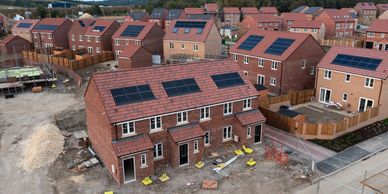Housing & Communities
Residential Construction

This section will discuss the needs to address the housing shortage in the U.K. but must also include the infrastructure that communities need to flourish.
As a late addition as we see pressures on the green belt and the introduction of the grey belt (defined as green belt of limited benefit).
This in it‘s own right is not saying that for example building on railway land is always the right decision. As the population continues to increase we have to be mindful of the need to expand our public transport infrastructure including the development of intermodal hubs to allow residents easy access to the railway network regardless of whether in a poorly connected areas of towns or from the rural communities dependant on their nearest railway station.
The right to buy shame introduced under Prime Minister Margaret Thatcher saw many homes sold but this essential housing stock was not replaced. We need to ensure that we have sufficient home of all types/sizes to serve our local communities but ensuring high standards are maintained.
Where we see new estates constructed we also need to take into account the design of the roads to support bus routes, waste collection and delivery vehicles or emergency services. The provision of parking not only needs to cater for residents but also for careers, district nurses/paramedics providing care at home. We need to consider the reasonable predictable changes we will need in our homes as we get older or as we may develop health issues. We also need to see new build garages constructed to accommodate modern vehicles and where possible the includion of a front garage on houses which has sufficient space to accommodate parking for a minimum of 1 vehicle.
Our private landlords and social housing providers must also see the standards brought significantly up with many people complaining about mould, poor quality maintenance/repairs, poor value for money and even threats to vacate or significant rises in the cost of tens to push tenants out. Whilst there will naturally be some good landlords and social housing providers we need to ensure that high standards are maintained across the rental market.
Social housing

The standards of performance between different social housing providers is remarkable. We need to see stronger regulation of social housing providers to ensure that poorly performing providers are held to account for their service standards.
Every organisation has the potential to improve and that is a constantly changing target as circumstances, technologies and more variable factors evolve. However we need to ask whether it is best to have social housing providers focus on smaller geographical areas as some of the very large ones lack the localism that helps develop services that are suitable for the individual needs of various communities that they serve.
It is reasonable to however work with social housing providers to look to construct new homes or complete renovations to out of us properties to see the increasing of social housing stock.
Schemes like the Liverpool Webster Triangle project also highlight the potential to work collaboratively with good results in renovating stock both for private individuals seeking to make the first step into the property ladder but also potentially for social housing providers to also increase their estate at a potentially lower cost than new construction would entail.
As so many homes were purchased through the Right to Buy scheme including leasehold properties it is only right that the service standards to home owners in leasehold properties is also monitored to ensure all types of residents in the social housing providers accommodation is duly taken into consideration.
Affordable housing

For too long we have seen too many developers avoid the provision of affordable homes and this includes a development of 250 flats in a commuter belt area, how that can be the case leaves us lost for words.
The term ”affordable housing” is also questionable as the cost of a lot of the affordable homes is fiscally out of the reach of those that would benefit the most from them.
We need to see changes to include truly affordable properties but also where this is not going to be provided a requirement for social housing provision to also be considered.
Community infrastructure to support housing development

Many of us will have seen the increased pressures that our communities face whilst large scale development is still continuing to be build or approved.
Community assets such as shops, schools, community centres, GP & Dental practices are only a few of the examples we need but often these appear as after thought's rather than essential infrastructure that needs to be in place to support our new build communities.
Even where we see smaller developments including the replacement of homes with flats or back garden developments we need to consider the impact on existing services.
In Surrey we have two different NHS trusts with similar catchment areas but significant differences in physical infrastructure. Frimley Health who operates Frimley Park Hospital (due to be relocated due to the RAAC issues in the current site) and Wrexham Park both with Emergency Departments to serve their catchment area of approximately 800,000 residents whilst on other side of the county Surrey & Sussex Healthcare who operate East Surrey Hospital has a catchment area of approximately 740,000 residents through one ED.
Both these trusts needs the development of their sites to handle the increased numbers of homes that central government insist need to be built but this along will not resolve the issues as we have seen the selling of land at St Peter’s Hospital in Chertsey that could have seen future healthcare needs met on one site.
We have also seen the closure of community and cottage hospitals which also prevents the discharging of patients to more appropriate settings. Yet, we hear of home building but no more information on how the essential services that these residents will need will be provided.
We must not forget that the “build baby build” ethos of Prime Minster Kier Stramers plans will also impact the utilities so what is being done to help safeguard regional water supplies when we see hot summers like 2025 depleting the reservoirs or over the last couple of years the impact of the failures in our drainage and sewage systems to stay on top of the increased demands growing communities will impact.
Changing planning rules
Changing planning rules

Housing:
New properties should have a front garden and garage for the provision of 1-2 parking spaces and where a garage is provided the side should be able to accommodate modern sized vehicles.
The length of the front garden is also a crucial factor for allowing the future-proofing of property should an occupant become a wheel char user Allowing space for a ramp to be added.
Energy efficiency is also something that needs to be taken into consideration when designing new buildings or modifications to help lower the crippling energy bills that residents and businesses alike like face.
We also need to better plan ahead with our town and county plans to ensure that we cater for increased footfall in our town centres and around public transport infrastructure. The development of intermodal transport hubs between active travel, taxis, buses and trains needs to be a significant factor in the connecting of the wider area served by our rail and bus station via more sustainable transport methods. This principle is also key to the old principle of carrot and stick - a carrot to encourage uptake and sticks to make life harder. If it is too difficult to use sustainable travel methods because of a lack of connectivity, frequency and affordability private vehicles will continue to be the preferred option. The trick is to get the carrots out first give people the opportunities to see there is an alternative before you make it harder for them. This said there will be those that have no option but to drive including those working at antisocial times when transport options are not available.
There also needs to be more emphasis on improving inclusion as seen with some public buildings over the years they have not always been good at catering for the needs of the less mobile. We should aim to have legislation or as a bare minimum the requirement to significantly improve accessibility in new buildings and where it is reasonably practicable in developments. All too often it feels that the needs of the disabled, elderly or vulnerable are not being taken into consideration when plans are being developed. We need to see more engagement with community representatives including organisations working with those that need to use inclusive facilities when working on public access buildings. Where current statutory consultants lack sufficient staffing resources to complete an effective assessment then more local organisations should be added to the list of mandatory statutory consultants.